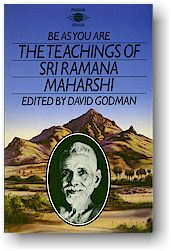| To Netnews Homepage Index |
|
 David
Godman (Editor) David
Godman (Editor)The Teachings of Sri Ramana Maharshi Be as You Are 251 pages «That in which all these worlds seem to exist steadily, that of which all these worlds are a possession, that from which all these worlds rise, that for which all these exist, that by which all these worlds come into existence and that which is indeed all these - that alone is the existing reality. Let us cherish that Self, which is the reality, in the Heart.» - S. Om (tr.), The Original Writings of Sri Ramana, Ulladu Narpadu Anubandham benedictory verse The teachings in this book are presented in the form of a series of questions and answers in which Sri Ramana outlines his views on various subjects. Each chapter is devoted to a different topic and each topic is prefaced by a few introductory or explanatory remarks. The questions and answers which form the bulk of each chapter have been taken from many sources and assembled in such a way that they give the appearance of being a continuous conversation. - David Godman, Introduction «Question: For one who has realized his Self, it is said that he will not have the three states of wakefulness, dream and deep sleep. Is that a fact? Answer: What makes you say that they do not have the three states? In saying 'I had a dream; I was in deep sleep; I am awake', you must admit that you were there in all the three states. That makes it clear that you were there all the time. If you remain as you are now, you are in the wakeful state; This becomes hidden in the dream state; and the dream state disappears when you are in deep sleep. You were there then, you are there now, and you are there at all times. The three states come and go, but you are always there. It is like a cinema. The screen is always there but several types of pictures appear on the screen and then disappear. Nothing sticks to the screen, it remains a screen. Similarly, you remain your own Self in all the three states. If you know that, the three states will not trouble you, just as the pictures which appear on the screen do not stick to it. On the screen, you sometimes see a huge ocean with endless waves; that disappears. Another time, you see fire spreading all around; that too disappears. The screen is there on both occasions. Did the screen get wet with the water or did it get burned by the fire? Nothing affected the screen. In the same way, the things that happen during the wakeful, dream and sleep states do not affect you at all; you remain your own Self.» Question: But why should these three states come and go on the real state or the screen of the Self? Answer: Who puts this question? Does the Self say these states come and go? It is the seer who says these come and go. The seer and the seen together constitute the mind. See if there is such a thing as the mind. Then, the mind merges in the Self, and there is neither the seer nor the seen. So the real answer to your question is, 'They neither come nor go.' The Self alone remains as it ever is. The three states owe their existence to non-enquiry and enquiry puts an end to them. However much one may explain, the fact will not become clear till one attains Self-realisation and wonders how one was blind to the self-evident and only existence so long? Question: What is the difference between the mind and the Self? Answer: There is no
difference. The mind turned inwards is the Self; turned outwards, it becomes the ego and
all the world. Cotton is made into various clothes we call by various names. Gold made
into various ornaments, we call by various names. But all the clothes are cotton and all
the ornaments gold. The one is real, the many are mere names and forms. - The nature of the Self, page 14 ff. From the table of Contents:
Sri Ramana Maharshi (1879 - 1950) is one of the most significant spiritual teachers to emerge from India during the first half of the 20th century, and remains widely admired. David Godman is the past librarian of Sri Ramana's ashram and a former editor of The Montain Path, a journal which propagates Sri Ramana's teachings. Last Updated Sunday, February 14, 1999 |
|
| To Netnews Homepage Index |